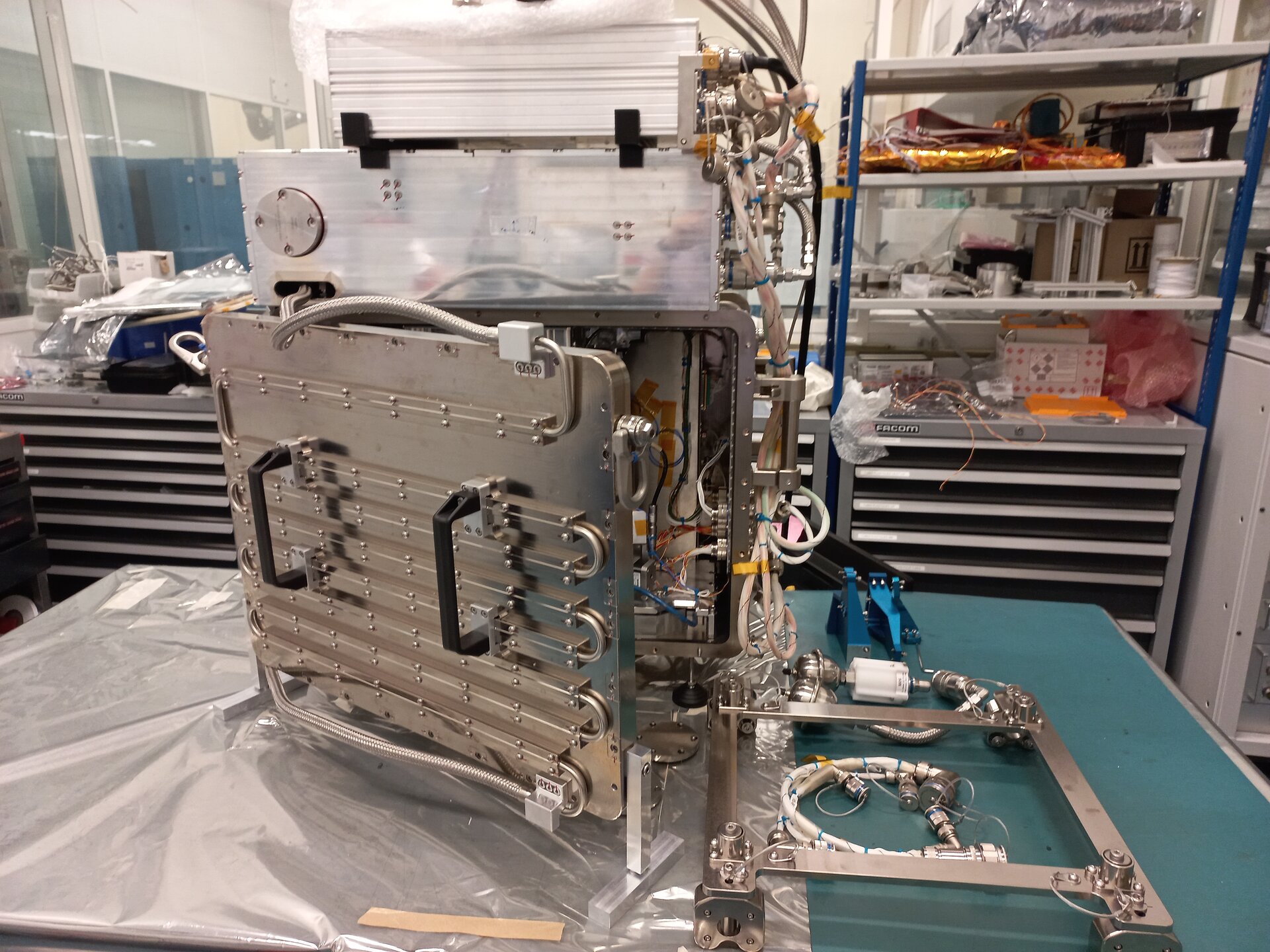Once again, the International Space Station (ISS) is set to receive 3D printed experiments on its upcoming resupply mission, an indication of the growing role of this technology in space exploration. The 20th Northrop Grumman commercial resupply services mission for NASA, launching no earlier than January 29, 2024, aboard a Falcon 9 rocket from Cape Canaveral Space Force Station in Florida, will deliver two 3D printing projects: a 3D cartilage cell culture experiment and the European Space Agency‘s (ESA) metal 3D printer. These projects highlight the innovative use of 3D printing technology in microgravity and its potential to revolutionize space science and exploration.
ESA’s 3D printing mission
A highly anticipated project aboard this mission is ESA’s metal 3D printer, representing a significant step in autonomous semiconductor manufacturing in space. Additionally, this printer will investigate how printed metal shapes behave in microgravity compared to those produced on Earth. The insights gained from this experiment could be pivotal in developing new manufacturing techniques for space missions, including potential future habitats on the Moon or Mars.
ESA’s metal 3D printer project is closely tied to the Huginn mission, led by ESA astronaut Andreas Mogensen, who will also oversee the operation of other European science experiments. Named after the raven Huginn from Norse mythology, symbolizing thought, the mission reflects Mogensen’s goal of gathering and relaying scientific knowledge from the ISS. The mission patch notably features the raven with Denmark’s silhouette, highlighting Mogensen’s heritage.
Mogensen will serve as the pilot for the SpaceX Crew Dragon, becoming the first European astronaut to undertake this role. During his stay on the ISS, Mogensen will oversee more than 20 European science experiments, including monitoring the 3D printing of metal objects. The successful operation and results of the metal 3D printer under the unique conditions of microgravity will be crucial for advancing manufacturing techniques for future space exploration and habitation. This technology demonstrator could revolutionize how we manufacture and repair tools and parts in space.
A new chapter in space
This printer will compare metal shapes expanded and shrunk in space versus those on Earth. The metal 3D project is a collaborative effort led by ESA involving several industrial and academic partners. Airbus (EPA: AIR), Italian aerospace company Highftech Engineering, French metal 3D printing leader AddUp, and Cranfield University were key contributors to this project. Each partner played a critical role in the development and implementation of the printer.
The Airbus Defence and Space teams in Toulouse have managed the project, taking responsibility for integrating the printer’s components and power supply and ensuring its compatibility with the space environment. Cranfield University was in charge of the energy source and material delivery mechanism, which includes the laser and stainless-steel wire. Highftech Engineering took on the task of manufacturing the machine’s enclosure and integrating its fluid management system. Meanwhile, AddUp (a Fives and Michelin joint venture) was instrumental in creating the internal structure and mechanisms of the printer, including the PLC (Programmable Logic Controller) that controls it and the interface for communication with ground control.
Although the dispatch of the printer to the ISS is scheduled for January 2024, plans for its future are already underway. AddUp and Airbus Defence and Space have established a joint project to develop a machine inspired by the metal 3D printer.
Breaking new ground
The second notable project is the 3D Cartilage Cell Culture, named Compartment Cartilage Tissue Construct. It’s a biological experiment exploring how to maintain healthy cartilage in microgravity. This research is crucial for astronauts on long-term missions, where microgravity can lead to cartilage degradation. The implications of this study are far-reaching, potentially leading to new ways to treat cartilage damage in space and on Earth. This groundbreaking project was developed under the guidance of the University of Connecticut‘s (UConn) Biomedical Engineering professor, Yupeng Chen, who has been instrumental in advancing tissue research for therapeutic applications.
This project uses innovative techniques to grow cartilage, the flexible tissue found in our joints. It employs a special multi-compartment tissue-engineered construct (MTEC), which acts like a mini-lab for growing cartilage. This MTEC system is designed to create an environment closely resembling the natural conditions needed for cartilage to grow and stay healthy. Chen’s team, working with a NASA contract, aims to use the microgravity environment of the ISS to fabricate biomaterials that could revolutionize treatment for conditions like arthritis, cancer, and neurological diseases on Earth.
Space medicine
At its core, MTEC has two main functions. The first is to provide a stable foundation where cartilage cells can thrive. This foundation is crucial because it mimics the body’s natural environment, allowing the cells to grow as they would normally. The second function involves the delivery of essential RNA (Ribonucleic acid) molecules to the cartilage cells. These RNA molecules play a key role in maintaining the health of the cartilage. They are essential in space, where the absence of gravity challenges the average growth and health of these cells. The ISS experiments, led by Chen and his team, will focus on fabricating novel biomaterials like Janus base nanomaterials (JBN), which are pivotal in regenerating tissues such as cartilage.
“This project will establish a roadmap to commercialize the in-space manufacturing strategy for a family of DNA-inspired Janus base nanomaterials used for tissue regeneration,” says Chen. “Leveraging the benefits of microgravity in the fabrication process has the potential to deliver more orderly JBN structures to achieve better structural integrity and therapeutic outcomes.”
Looking ahead, Chen’s team at UConn plans to expand their promising research beyond the ISS, aiming for more groundbreaking developments. In collaboration with aerospace company Axiom Space, they aim to explore advanced bio-manufacturing processes in space. This partnership could lead to more sophisticated techniques for producing biomaterials in microgravity. Axiom’s expertise in spaceflight operations could also open doors to longer-term missions, potentially on Axiom’s commercial space station, which is targeting a launch for its first module in late 2025 and aims to be fully operational in the late 2020s. These future endeavors aim to pioneer the commercialization of space-manufactured biomedical products, potentially revolutionizing medical treatments on Earth.
Why These Projects Matter
The inclusion of these 3D printing experiments in the upcoming mission continues a trend that has been gaining momentum over the past few years. 3D printing in microgravity has many advantages, including producing necessary tools and components on-demand and reducing the need for extensive cargo shipments from Earth. Several 3D printing experiments have been sent to the ISS, like the BioFabrication Facility (BFF) by Redwire (NYSE: RDW) or the 3D Printing In Zero-G Experiment, the first 3D printer specifically designed for microgravity, brought to the ISS in 2014.
As humanity looks towards deep-space missions to the Moon and Mars, the ability to create and maintain vital components and biological materials in space will be essential. The upcoming resupply mission represents more than scientific experiments; it’s a step towards a future where space travel can be safer, medical care in space more advanced, and manufacturing in space might be a reality. These experiments also highlight the ISS’s role as a hub for pioneering research, paving the way for NASA’s Artemis missions to the Moon and beyond.
Subscribe to Our Email Newsletter
Stay up-to-date on all the latest news from the 3D printing industry and receive information and offers from third party vendors.
Print Services
Upload your 3D Models and get them printed quickly and efficiently.
You May Also Like
Making Space: Stratasys Global Director of Aerospace & Defense Conrad Smith Discusses the Space Supply Chain Council
Of all the many verticals that have been significant additive manufacturing (AM) adopters, few have been more deeply influenced by the incorporation of AM into their workflows than the space...
EOS in India: AM’s Rising Star
EOS is doubling down on India. With a growing base of aerospace startups, new government policies, and a massive engineering workforce, India is quickly becoming one of the most important...
PostProcess CEO on Why the “Dirty Little Secret” of 3D Printing Can’t Be Ignored Anymore
If you’ve ever peeked behind the scenes of a 3D printing lab, you might have caught a glimpse of the post-processing room; maybe it’s messy, maybe hidden behind a mysterious...
Stratasys & Automation Intelligence Open North American Tooling Center in Flint
Stratasys has opened the North American Stratasys Tooling Center (NASTC) in Flint, Michigan, together with automation integrator and software firm Automation Intelligence. Stratasys wants the new center to help reduce...





































